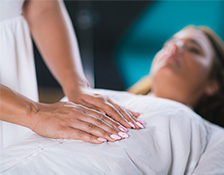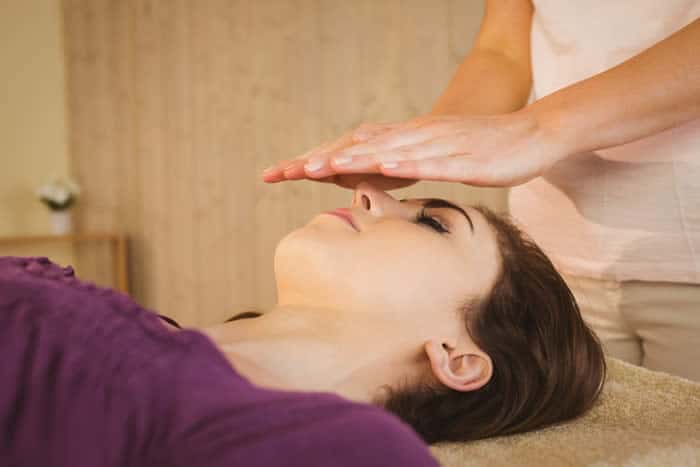

 Want to earn continuing education credit for this article? Learn more.
Want to earn continuing education credit for this article? Learn more.
Reiki is considered a practice passed down orally from master to student; however, anybody can learn how to apply this healing tradition. Administered by laying-on of the hands, Reiki’s popularity is growing in the United States. Massage therapists who learn to incorporate Reiki into their sessions have an additional, non-invasive tool to help their clients.
Many have debated the correct Reiki hand positions, forgetting that this healing modality is more of an art form than an exact science. Even though different Reiki schools teach their own guidelines for hand positioning, a Reiki practitioner’s goal is to help guide proper energy flow in the recipient – this intention does not rely on precise hand locations.
Most schools of modern Reiki follow a process of specific Reiki hand placements corresponding with the seven Chakras of the body – beginning at the head and working down to the feet. This approach delivers a session akin to a total body tune-up. Traditional or Oriental Reiki schools give more control to the practitioner, focusing on specific problem areas and relying on intuition more than adherence to a rigid protocol. Nonetheless, one of the ways Reiki differs from laying-on of hands and touch healing is its use of formal physical positions for applying energy over the chakras.
In Reiki hand positioning, the thumb and fingers are typically held close together. Because each finger contains the ending of a zone or meridian with alternating positive or negative charges, keeping them all together creates a linked energy field – resulting in a stronger, unified healing power. Since the hand positions are primarily located over the chakras, a deep understanding of the chakra system is helpful when studying of Reiki. Each chakra is associated with its own physical, emotional, and spiritual issues; thus, this knowledge is particularly important for the therapeutic nature of a Reiki session.
Every hand position is typically held for several minutes – or until an energetic change is detected. It’s important for the practitioner to be in a comfortable, relaxed position. Beginning at the most superior chakra and then descending, here is a general description of Reiki’s hand positions:
 Brow – Without applying any pressure, the hands are delicately positioned on (or over) the recipient’s face, with the palms cupped over the eyes and fingers on the cheekbones. This position is best applied sitting behind the head of a supine client.
Brow – Without applying any pressure, the hands are delicately positioned on (or over) the recipient’s face, with the palms cupped over the eyes and fingers on the cheekbones. This position is best applied sitting behind the head of a supine client. Third Eye/Brow/Crown – On the sides of the head, the fingers are in front of or over the recipient’s ears – resting the palms on the client’s temples. This position is best applied sitting behind the head of a supine client.
Third Eye/Brow/Crown – On the sides of the head, the fingers are in front of or over the recipient’s ears – resting the palms on the client’s temples. This position is best applied sitting behind the head of a supine client. Crown/Occiput – Behind the head, fingers touch the top of the neck, allowing the occiput to rest naturally in the practitioner’s slightly cupped palms. This position is best applied sitting behind the head of a supine client.
Crown/Occiput – Behind the head, fingers touch the top of the neck, allowing the occiput to rest naturally in the practitioner’s slightly cupped palms. This position is best applied sitting behind the head of a supine client. Throat – The hands come across both sides of the throat so that the fingers meet in the center, with the hands either making a tent over the throat or gently resting on the throat. Since many find this chakra extra sensitive, additional awareness of the client’s comfort is warranted. Alternate placements are one hand at the front and the other at the back of the neck or creating a V with the hands just below the throat. This position is best applied sitting behind the head of a supine client.
Throat – The hands come across both sides of the throat so that the fingers meet in the center, with the hands either making a tent over the throat or gently resting on the throat. Since many find this chakra extra sensitive, additional awareness of the client’s comfort is warranted. Alternate placements are one hand at the front and the other at the back of the neck or creating a V with the hands just below the throat. This position is best applied sitting behind the head of a supine client. Heart – With hands beside each other or end-to-end (fingers of one hand at the wrist of the other), hands are placed over the breastbone or above the breasts. This can also be a sensitive location; steps must be taken to respect the client’s boundaries.
Heart – With hands beside each other or end-to-end (fingers of one hand at the wrist of the other), hands are placed over the breastbone or above the breasts. This can also be a sensitive location; steps must be taken to respect the client’s boundaries. Solar Plexus – Hands are held beside each other on one side of the recipient’s lower ribs and then moved to the other side. This position is best applied sitting to one side of the client.
Solar Plexus – Hands are held beside each other on one side of the recipient’s lower ribs and then moved to the other side. This position is best applied sitting to one side of the client. Solar Plexus/Belly – Below the ribs, hands are placed end-to-end across the recipient’s waist, covering most of the internal organs. This position is best applied sitting to one side of the client.
Solar Plexus/Belly – Below the ribs, hands are placed end-to-end across the recipient’s waist, covering most of the internal organs. This position is best applied sitting to one side of the client. Belly – Hands are placed over the pelvic bones. Most schools describe this position with hands pointing inferiorly over the pelvic bones. Again, this position is best applied sitting to one side of the client. Despite some concerns, this Reiki position is considered safe for pregnancy.
Belly – Hands are placed over the pelvic bones. Most schools describe this position with hands pointing inferiorly over the pelvic bones. Again, this position is best applied sitting to one side of the client. Despite some concerns, this Reiki position is considered safe for pregnancy.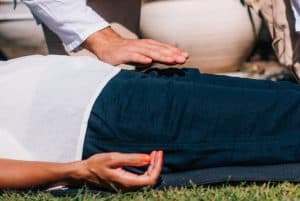 Root – The hands are brought together in the center of the lower abdomen, one above the other, just above the pubic bone. Due to the sensitive nature of this location, some practitioners will skip the root chakra. However, it can be a very powerful Reiki location. Thus, some prefer to include this position but keep their hands above the body, so that no physical contact is made here.
Root – The hands are brought together in the center of the lower abdomen, one above the other, just above the pubic bone. Due to the sensitive nature of this location, some practitioners will skip the root chakra. However, it can be a very powerful Reiki location. Thus, some prefer to include this position but keep their hands above the body, so that no physical contact is made here.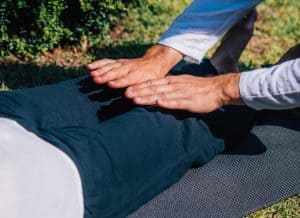 Knees – Several schools consider this position optional, but it can be greatly appreciated by clients with knee problems. Best applied sitting to one side of the client, one hand is generally placed over each patella.
Knees – Several schools consider this position optional, but it can be greatly appreciated by clients with knee problems. Best applied sitting to one side of the client, one hand is generally placed over each patella.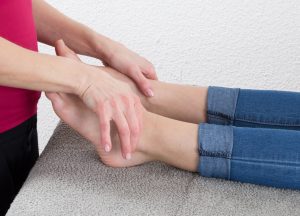 Ankles – Also regarded as an optional Reiki location, this position involves covering the ankles with the hands. This can be applied by sitting next to the client or inferior to the client’s feet – in preparation for the closing Reiki hand placement.
Ankles – Also regarded as an optional Reiki location, this position involves covering the ankles with the hands. This can be applied by sitting next to the client or inferior to the client’s feet – in preparation for the closing Reiki hand placement.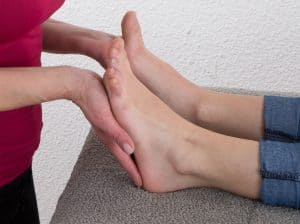 Feet – The final position is to place hands on the soles of the feet. This helps treat the feet and also integrates the treatment and grounds both the Reiki giver and the recipient.
Feet – The final position is to place hands on the soles of the feet. This helps treat the feet and also integrates the treatment and grounds both the Reiki giver and the recipient.
As described earlier, many different sequences and interpretations of Reiki hand placement exist. Added to the Crown/Occipital hold, many Reiki practitioners include the Cranial-Sacral technique of finding the Still Point to aid spinal alignment. Another popular approach is to proceed with similar locations on the body’s posterior surface for a client who has turned over and is lying prone – but still concluding with the soles of the feet.
Regardless of the type of Reiki preferred or the variations that fit in best with a practitioner’s style, there is no doubt that this healing approach can work wonders. The guidelines of Reiki hand placement have been described to give practitioners a framework for understanding this healing art. Although, proper training in Reiki has proven invaluable for healthcare providers in delivering the best of this energetic healing system to their clients.
You can find numerous resources online regarding hand placement and sequences. Here are just a few:
- Reiki I Hand Positions sheet
- Hand Positions for Reiki video
- Reiki Hand Positions for Healing Others with Downloadable PDF Chart
- Reiki Hand Placements for Treating Others
- Reiki Hand Position Poster
- Reiki Hand Positions – Part 1: Beginning Reiki Certification video
Editor’s Note: To learn more about Reiki from a Reiki Master, Pamela Miles, and sign up to receive timely Reiki information, visit http://reikiinmedicine.org. Also, for research pertaining to Reiki, please visit https://centerforreikiresearch.com/reiki-research-list/.
Earn continuing education credit for this article contained in our Reiki: An Introduction series. Click here to enroll.

